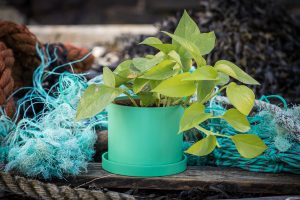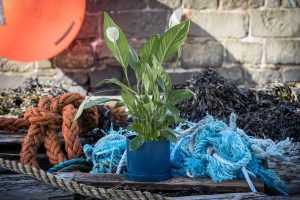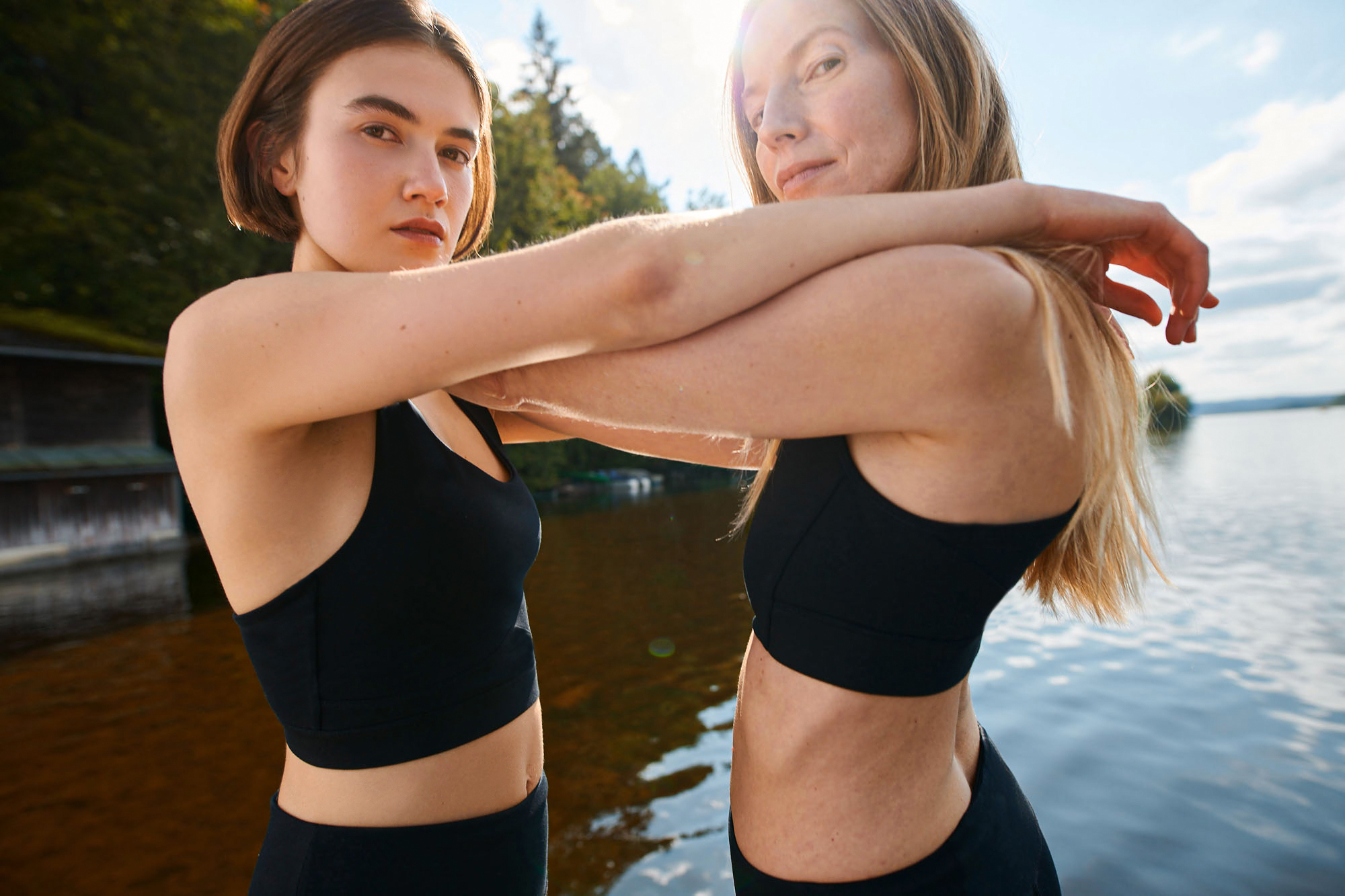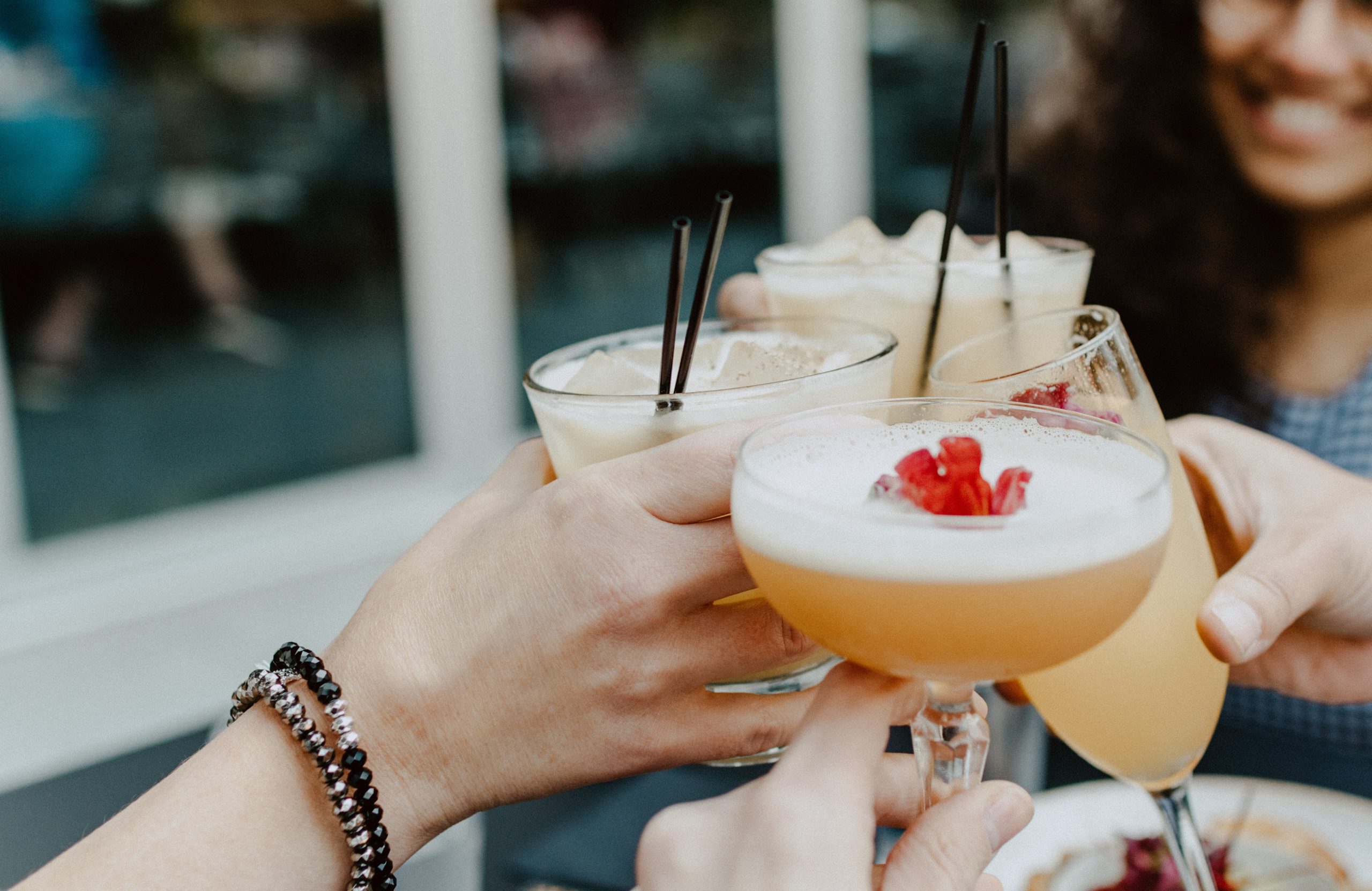Commercial diver Ally Mitchell started Ocean Plastic Pots after a job salvaging a ship full of plastic off the west coast of Scotland. He started making his colourful plant holders in his garden shed with plastic and rope collected from harbour skips and beaches. He tells Frank how he planted the seeds of his award-winning business.
Ally, we absolutely love Ocean Plastic Pots. Tell us how you started.
Ally Mitchell: On the first day of lockdown in 2020, the ship MV Kaami hit a reef and ruptured her hull when leaving the shipping channel between Skye and Harris. She was carrying about 2,000 tonnes of waste plastic, which was threatening to leak out into the sea as she filled with water at high tide.
I’d been a commercial diver for the past 13 years and was asked to join the salvage team by HM Coastguard. We dived around the ship to survey the damage, and then inside to patch up any holes and stop the plastic from flowing into the sea, before removing it with a dredge pump. We were literally diving in a sea of waste plastic. It was eventually cleared and the ship recycled but this was the first time I’d seen plastic waste of that scale threaten somewhere I loved.
That was the big moment for me, but I had the idea about six months earlier when I was working at Peterhead Harbour in Edinburgh and we put a tonne of polypropylene rope in a skip. I’d been growing plants on the kitchen windowsill with my children and had read that you couldn’t recycle black plastic plant pots because of the colour. I had all this colourful blue and green waste rope made from the same material through work and had a flash thought of ‘I could make plant pots with that’.
With lockdown, I had lots of time to let the idea develop. I filled my pickup truck with polypropylene rope and waste plastic from the beach and set to researching plastic recycling.

Was it just yourself picking up plastic and rope from the beaches?
Ally Mitchell: I recycled the plastic myself at first, working through the lot I’d picked up and other bits and pieces from beach cleans I was doing with my family. I bought some basic moulding equipment and started making small pots in the garden shed, producing up to three pots in eight minutes.
We sold them at Leith market as a test to see if people would buy the pots. We displayed them with waste plastic collected from the local beach and they sold out quickly – people were loving them.
This wasn’t commercially viable though, so I took a huge gamble and spent the price of a family car on a mould to prototype the pots. I spoke to the Royal Horticultural Society who loved what I was doing and invited me to attend Chelsea Flower Show in London, which was amazing. I’d always wanted to go – my problem was I didn’t have any plant pots yet!
We knew we had to do it though, so we started working with a Scottish manufacturer to produce the pots and put our Chelsea trip on a credit card – and then we were off! A month later we had the Chelsea pot and were selling it online.
Talk us through the Ocean Plastic Pots range.
Ally Mitchell: I’m really proud of our range and have been working hard to expand the colours and sizes available. We collect discarded fishing rope and nets from all over Scotland, which are then shredded and moulded into our pots – some of our first handmade pots even had plastic from the MV Kaami in them.
The colour of the pots comes directly from the rope and net they were originally.
We’ve been experimenting with mixing rope colours and have created some lovely shades like peach, mint green and marbled navy. We even used 700 red fishing boxes to create a limited run of pink pots, which our customers loved.
The original Ocean Plastic Pot is the 15cm Chelsea, which won Sustainable Product of the Year at the Royal Chelsea Flower Show in 2021. Bloom & Wild approached me last year and we made a pot just for them, the 13cm Bloom Pot.
We’re about to launch our largest 20cm pot at the RHS Chelsea Flower Show this month. We’ve used rope from Inverness to give us a vivid, matte yellow. We’re the first company to recycle yellow mooring rope specifically – and it will also come in navy, marble, light blue and grey.
Congratulations on winning the Sustainable Garden Product Award of the Year at RHS Chelsea Flower Show in 2021 – and for being a finalist again this year. How does it feel to be getting this recognition?
Ally Mitchell: We had such a positive response since winning at Chelsea Flower Show. We’ve been delighted with the interest we’ve had since, and how much support people have given us as a small sustainable start-up business.
Interest rocketed after we won and since then we’ve been approached by lots of retailers who want to stock Ocean Plastic Pots or work with us, including some big names. We’ve done corporate gifting for large multinationals and are working on an exciting project with a big supermarket too.
It’s brilliant to be nominated again and we’re really proud to stand alongside other companies in horticulture who are doing their bit to contribute sustainability to a circular economy.
Do you still scour beaches or do you source the recycled materials in another way now?
Ally Mitchell: We source the fishing nets and rope in a few different ways now, but once you’ve started seeing waste plastic, you won’t stop. I still pick up bits of discarded nets and rope as I go when I’m out walking with my son.
I knew the harbour master at Dunbar from diving and we’ve now set up a collection point there. Keep Britain Tidy helped me find an innovative recycler in Scotland and I also work with Caledonian Heritage on the Scottish Coastal Clean-Up initiative.
We’ve just been to the beautiful Isle of Ulva for a three-day beach clean. We collected almost two tonnes of discarded rope and net that we’ll recycle into Ocean Plastic Pots.
Are Ocean Plastic pots more durable than the usual black nursery pots?
Ally Mitchell: Fishing rope and net are engineered to be strong. When the plastic is recycled, it retains those properties, making our pots super durable and robust. They can be recycled again, which contributes to Scotland’s circular economy and they have a CO2 saving five times that of virgin plastic.
The rope is also UV stable – it has to stay bright and visible in the water – so our pots won’t fade with the weather or the sun, keeping them bright and cheery whether they’re inside or out.
Black plastic pots aren’t easily recyclable and a lot of growers are moving to use other colours that are more easily recycled. We’re exploring ways to work with black plastic but in the meantime, I’d always try to reuse those pots as much as possible – give them to green-fingered friends, or use them to start seedlings or small herbs in.
You are an international diver. Where else have you dived in the world and seen ocean plastic? Have you seen it noticeably increase over the years?
Ally Mitchell: I’ve worked at depth all over Europe – Denmark, Holland, Norway, Spain – and in countries such as the Ivory Coast, Singapore and Congo.
10,000 tonnes of plastic enter the North Sea every year. 21% of it is fishing net and rope and it massively affects marine life. I used to see bundles of nets and rope floating about on almost every dive. And consumer plastic is everywhere now, including discarded plastic bottles and wrappers. Sadly, it’s got a lot worse.
Apart from your website, where can we find your pots?
Ally Mitchell: Ocean Plastic Pots are stocked at select home and garden shops across the UK, including Bloom & Wild, Kew Gardens, Tate Liverpool and the RHS.










